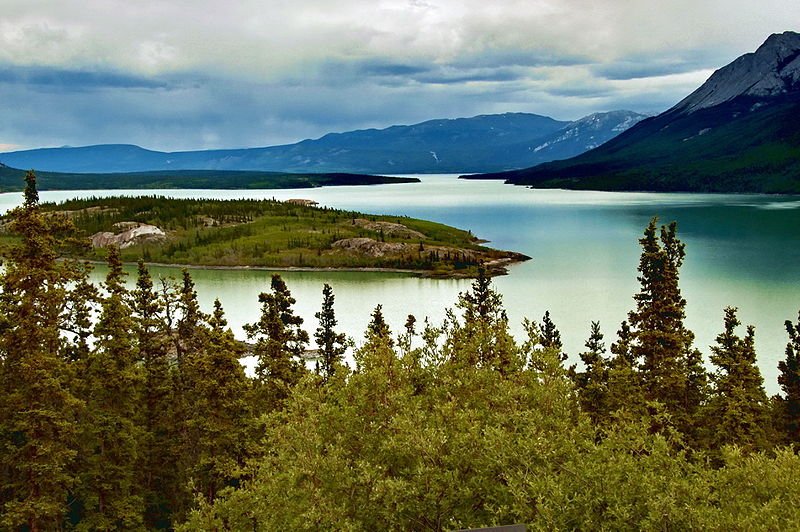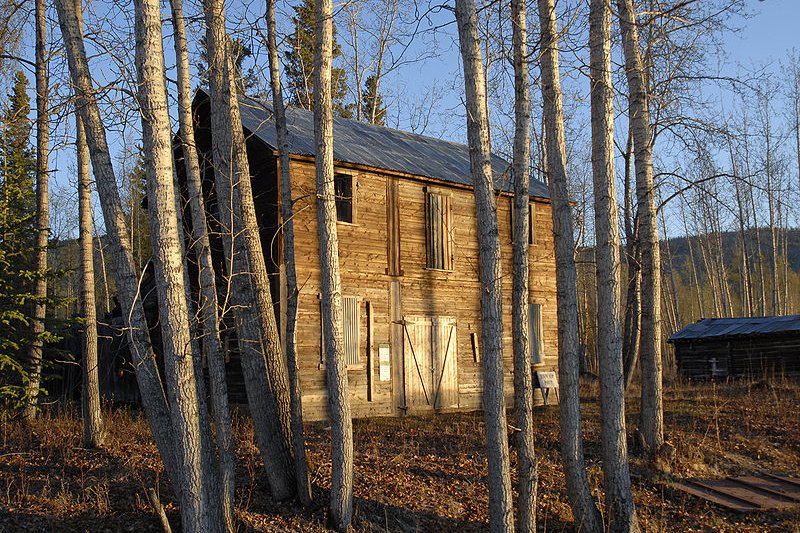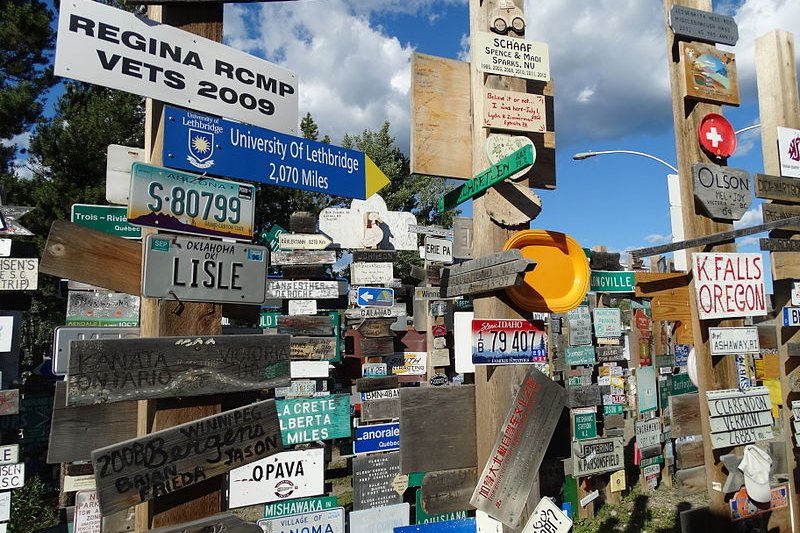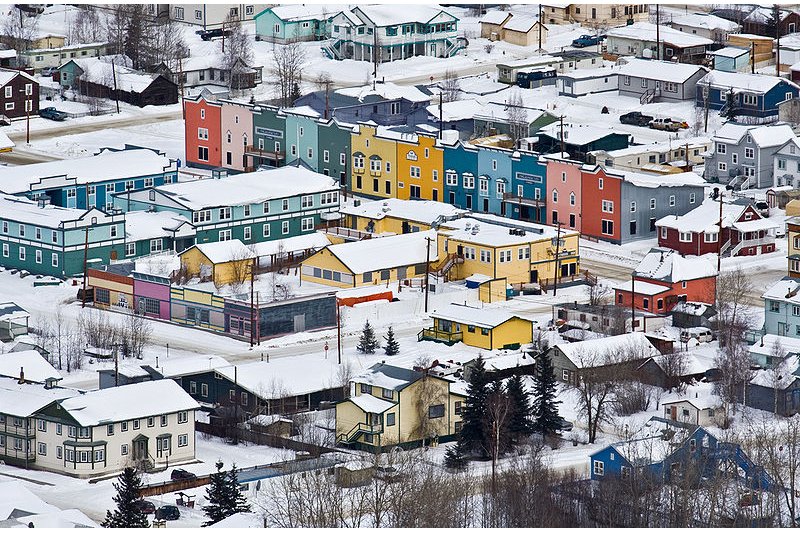 Yukon River
Yukon RiverSource: https://commons.wikimedia.org/wiki/File:Yukon_River_-c.jpg
Author: Dave Bezaire & Susi Havens-Bezaire

Cities and Sights in the Yukon
Yukon (YT) is one of the federal territories of Canada. Covering 482,443 sq km (186,272 sq mi), it is the westernmost and smallest of the three federal territories. Yukon is bordered by Northwest Territories to the east, British Columbia to the south and Alaska to the east. It faces Beaufort Sea to the north.
Yukan is sparsely populated, having a population of 34,000 people (2012 estimate) only. The capital and largest city is Whitehorse. Yukon has one seat in the 308-seat Canadian House of Commons and one seat in the 105-seat Senate of Canada. English and French are the official languages here. Yukon is home to Mount Logan, at 5,959 m (19,551 ft) the highest mountain in Canada and second highest in North America after Mount McKinley in Alaska.
 Royal North-West Mounted Police building at Forty Mile Historic Site
Royal North-West Mounted Police building at Forty Mile Historic SiteSource: https://commons.wikimedia.org/wiki/File:Forty_Mile_RNWMP.JPG
Author: Maedward

Remnants of animal bones bearing traces of human activity indicates human presence in the Yukon going back 25,000-40,000 years ago. This makes the Yukon having the earliest trace of human activity in North America.
European fur trading activity only penetrated the Yukon in the first half of the 19th century. During that time, the area was inhabited by the Athabaskan tribe of indigenous people. European explorers followed the Mackenzie River started at Fort McPherson, established by John Bell.
 Signpost Forest, Watson Lake
Signpost Forest, Watson LakeSource: https://commons.wikimedia.org/wiki/File:Signpost_Forest_-_Watson_Lake_-_Yukon_-_Canada_-_02.jpg
Author: Adam Jones, PhD

In 1845 Bell crossed the mountains into Yukon River, down the Rat River (now the Bell River) to reach the confluence of the Porcupine River. Soon after Alexander Hunter Murray and other Europeans were setting up trading posts in the Yukon, and following behind came Anglican and Roman Catholic missionaries.
In 1896 Skookum Jim Mason, an indigenous Canadian, discovered gold in Bonanza Creek, sparking the Klondike Gold Rush. Close to 40,000 prospectors converging on the Klondike gold fields, forcing the government to consider creating a separate territory out of the then Northwest Territories. As a result, Yukon Territory was formed in 1898. But as soon as the gold was exhausted, the population came down rapidly. In 1901, it stood at 27,219, a figure not reached again until 1991. The population of the Yukon dropped to as little as 4,157 in 1921.
 Dawson City, Yukon
Dawson City, YukonSource: https://commons.wikimedia.org/wiki/File:Dawson_City.jpg
Author: Dlogic

Today the economy of the Yukon is still dominated by mining, for lead, zinc, silver, gold, asbestos and copper. Tourism has also become a major income earner. A number of cultural and sporting events are created for the benefit of visitors from all over the world.
Visiting Yukon
There are direct flights to Whitehorse, Yukon, from Vancoouver on Air Canada. Air North also flies from Vancouver as well as from Calgary and Edmonton.Towns in Yukon
- Whitehorse - capital
Places of Interest in the Yukon
- Iwavik National Park
- Kluane National Park and Reserve
- Liard River Hot Springs Provincial Park
- Vuntut National Park
 Latest updates on Penang Travel Tips
Latest updates on Penang Travel Tips
 Discover with Timothy YouTube Channel
Discover with Timothy YouTube Channel
 PG Food Channel
PG Food Channel
 Learn Penang Hokkien YouTube Channel
Learn Penang Hokkien YouTube Channel
 SojiMart Videos
SojiMart Videos
Latest from Discover with Timothy: Gurney Bay - what to see and do there
About this website

Hello and thanks for reading this page. My name is Timothy and my hobby is in describing places so that I can share the information with the general public. My website has become the go to site for a lot of people including students, teachers, journalists, etc. whenever they seek information on places, particularly those in Malaysia and Singapore. I have been doing this since 5 January 2003, for over twenty years already. You can read about me at Discover Timothy. By now I have compiled information on thousands of places, mostly in Peninsular Malaysia and Singapore, and I continue to add more almost every day. My goal is to describe every street in every town in Malaysia and Singapore.
Robbie's Roadmap
- Episode 1: Robbie's Journey to Financial Freedom
- Episode 2: Lost in America
- Episode 3: The Value of Money
- Episode 4: The Mentor
- Episode 5: The Thing that Makes Money
- Episode 6: The walk with a Billionaire
- Episode 7: The Financial Freedom Awakening
- Episode 8: Meet Mr Washington
- Episode 9: The Pizzeria Incident
Copyright © 2003-2024 Timothy Tye. All Rights Reserved.


 Go Back
Go Back